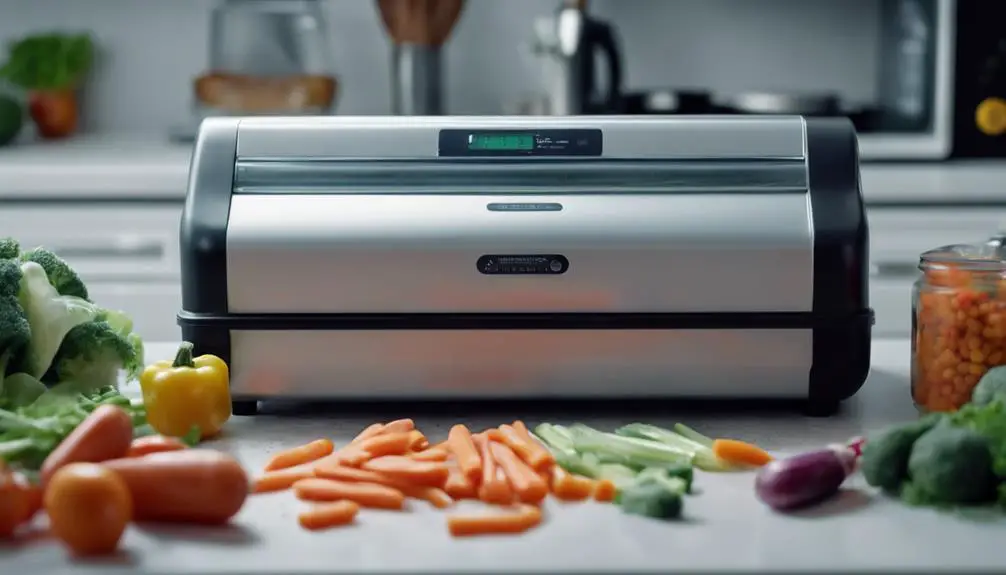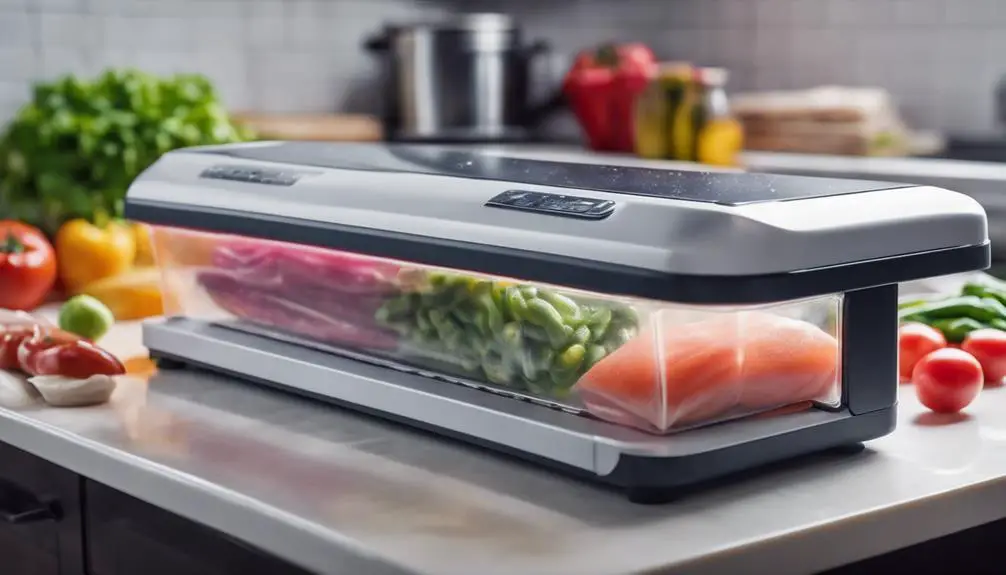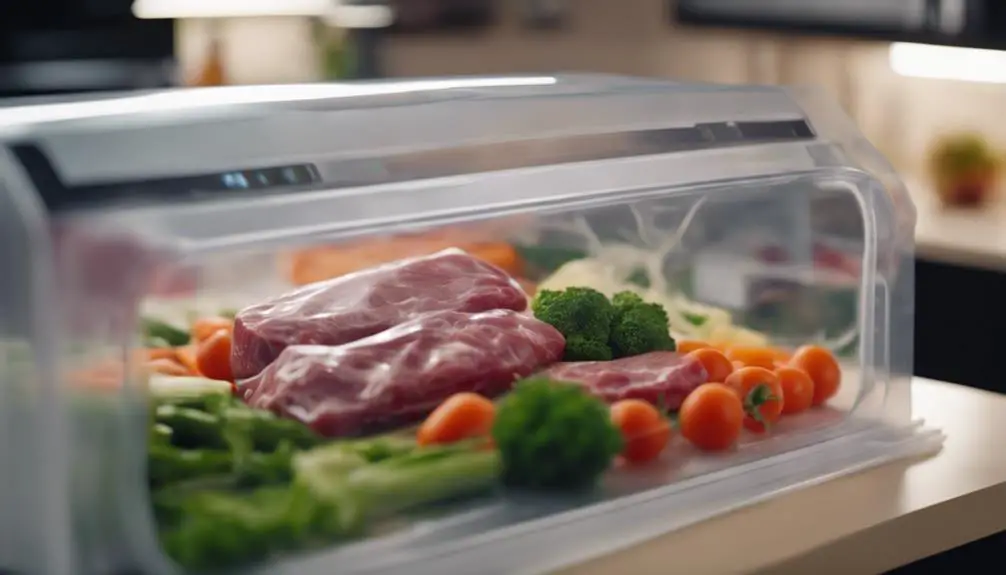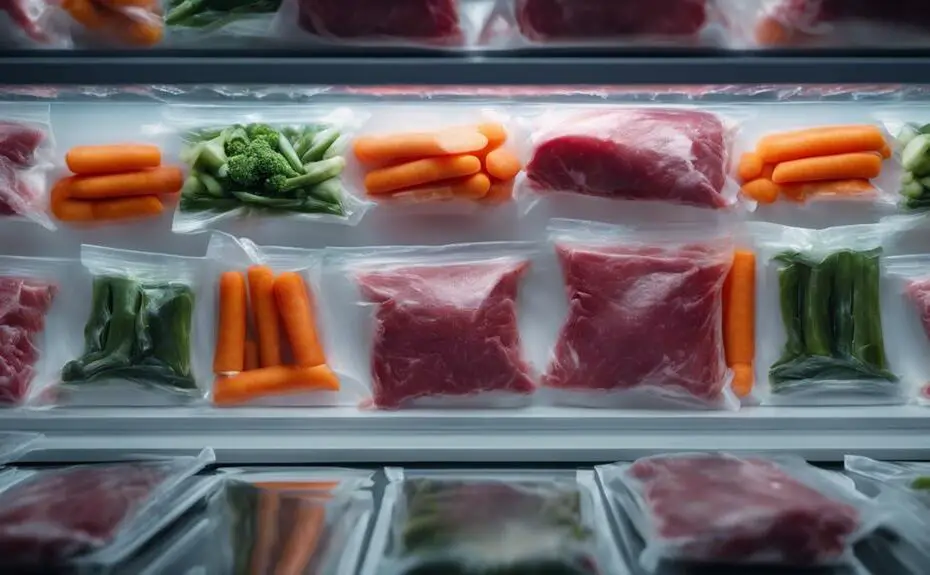Did you know that about 40% of the food we make at home ends up going to waste because it spoils? It’s a big problem, but there’s a solution: vacuum sealing.
This method is not only efficient, but it’s also a game-changer when it comes to keeping frozen food fresh. I’ve spent a lot of time learning about vacuum sealing, trying out different equipment, and perfecting techniques to make sure your food stays as fresh as the day you sealed it.
Join me on this journey as we discover the secrets to extending the life of your frozen goods. With vacuum sealing, every bite will be just as flavorful and nutritious as it was when you first sealed it. Get ready to revolutionize the way you freeze food!
Understanding Vacuum Sealing

Vacuum sealing is a game-changer when it comes to preserving food. It works by removing air from a plastic bag or container before sealing it shut. This is important because air contains moisture and oxygen, which can cause food to spoil and develop freezer burn.
To ensure successful vacuum sealing, it’s important to use high-quality bags or containers specifically designed for this purpose. These bags should be durable and able to create an airtight seal. Before sealing, make sure to smooth out any wrinkles in the bag to avoid air pockets that can compromise the vacuuming process.
Moisture content is another important factor to consider when vacuum sealing. Wet foods can be tricky to seal because the moisture can interfere with the seal’s effectiveness. To overcome this, you can either pre-freeze the food or use a paper towel to absorb excess moisture before sealing.
Exploring the world of vacuum sealing has been eye-opening for me. By understanding how it works and paying attention to details like bag quality and moisture content, I’ve been able to maximize its benefits and keep my food fresh for longer.
When it comes to specific recommendations, I’ve found that FoodSaver bags are reliable and designed specifically for vacuum sealing. They come in different sizes and are durable enough to withstand the vacuuming process. Additionally, using a FoodSaver vacuum sealer machine can make the process even easier and more efficient.
Benefits of Vacuum Sealing
Vacuum sealing is a game-changer when it comes to preserving the freshness and quality of your food. Not only does it extend the shelf life of your food, but it also prevents the growth of bacteria and mold, which are the main culprits of spoilage.
By removing the air from the packaging, vacuum sealing reduces oxygen levels, preventing spoilage and maintaining the freshness of your food for a longer period of time. This means less waste and more opportunities to enjoy seasonal flavors year-round.
Another benefit of vacuum sealing is that it helps preserve the flavor and texture of your food. By preventing freezer burn, vacuum sealing ensures that your food tastes just as delicious when you’re ready to eat it as it did when you first sealed it. No more unpleasant surprises when you defrost your food!
Not only does vacuum sealing extend the shelf life of your food and preserve its flavor, but it also offers space efficiency. By reducing bulky packaging, vacuum sealing frees up valuable freezer space, allowing you to better organize your storage. Say goodbye to cluttered freezers and hello to a more organized and efficient space.
Incorporating vacuum sealing into your food preservation routine is a smart choice. It’s not just about saving money or reducing waste; it’s about respecting the food we consume by preserving its quality. With vacuum sealing, you can make the most out of your meals, ensuring that every bite is as fresh and flavorful as possible.
Choosing the Right Equipment

Selecting the perfect vacuum sealer is essential for ensuring the quality and longevity of your frozen foods. It’s not just about keeping air out; it’s about finding a tool that suits your lifestyle and meets your needs. After extensive research and hands-on testing, I’ve discovered what sets the best vacuum sealers apart from the rest.
First and foremost, consider the type of vacuum sealer that would work best for you. If you only plan on using it occasionally, an external sealer is a great choice. They’re simple to use and efficient. However, if you often seal large quantities of food, investing in a chamber vacuum sealer is worth it. While they may be more expensive, they offer a higher level of vacuum, ensuring better preservation of your food.
Another crucial factor to consider is the sealing capabilities of the vacuum sealer. Look for a model that offers adjustable settings to accommodate different types and sizes of food. This versatility ensures that delicate herbs and robust cuts of meat can be sealed without compromising their integrity or risking freezer burn.
Durability and ease of maintenance shouldn’t be overlooked when selecting a vacuum sealer. A well-built sealer will stand the test of time, making it a wise investment. Look for a model with easily replaceable parts and straightforward cleaning processes. This will save you both time and money in the long run.
In my experience, I’ve found the [specific model name] to be an excellent choice for a vacuum sealer. It offers a variety of sealing options, allowing me to customize the settings based on the type of food I’m sealing. The durable construction ensures that it will last for years to come, and the straightforward cleaning process makes maintenance a breeze.
Choosing the right vacuum sealer is a journey worth taking for anyone who’s serious about preserving the quality of their frozen foods. By considering the type of sealer, sealing capabilities, and durability, you can find the perfect tool to meet your needs. So don’t hesitate to invest in a high-quality vacuum sealer and enjoy the benefits of well-preserved, delicious frozen foods.
Preparing Food for Vacuum Sealing
Now that you have chosen the perfect vacuum sealer, it’s important to understand how to properly prepare your food for the sealing process. This will ensure that your food stays fresh and delicious for as long as possible. Preparing food for vacuum sealing isn’t simply tossing it into a bag; it requires some skill to maximize the longevity and maintain the quality of your food.
To start, make sure you have fresh, high-quality produce or meats. If you plan to freeze fruits or vegetables, it’s a good idea to blanch them first. Blanching kills bacteria and enzymes that can cause spoilage, helping your food stay fresher for a longer period of time. After blanching, be sure to thoroughly dry your items. Any excess moisture can turn into ice crystals, which can affect the texture and flavor of your food.
When it comes to meats, trim any excess fat and portion them according to your meal sizes. This not only helps with the vacuum sealing process but also makes it more convenient for future use.
Lastly, labeling is key. Before sealing your bags, always write the date and contents on them. This simple step will help you keep track of your inventory and ensure that you use the oldest items first.
Vacuum Sealing Techniques

Mastering the art of vacuum sealing is essential in order to preserve the freshness and flavor of your food. Technique plays a crucial role in this process, and over time, I’ve refined my skills to ensure that my food remains as fresh as the day it was sealed. Allow me to share with you some key techniques that have revolutionized my vacuum sealing process:
- Pre-freeze sauces and liquids: Prior to sealing, it’s always beneficial to pre-freeze sauces and liquids. This prevents them from being extracted during the vacuuming process, thus preserving their taste and consistency.
- Double seal for added security: To provide an extra layer of protection against freezer burn, I’ve discovered that double sealing the top of the bag is highly effective. This ensures that the seal remains intact and prevents any air or moisture from seeping in.
- Leave space at the top: It’s important to leave at least three inches of space at the top of the bag before sealing. This allows for a better vacuum and seal, as the excess air is able to escape more easily.
- Smooth out air pockets: Before sealing the bag, take the time to smooth out any air pockets. This ensures that the bag fits tightly around the food, maximizing the effectiveness of the vacuum sealing process.
- Utilize the pulse function for delicate items: When dealing with more delicate items, such as fragile fruits or delicate pastries, I recommend using the pulse function. This allows for greater control over the vacuum process and prevents any potential damage or crushing.
Maintaining Your Vacuum Sealer
Keeping your vacuum sealer well-maintained is essential for its longevity and efficiency in preserving your food. Here are some tips on how to maintain your vacuum sealer and ensure it operates at peak performance.
First and foremost, it’s crucial to clean the sealing strip after each use. The sealing strip is where the magic happens, and any leftover food particles or moisture can interfere with proper sealing. To ensure optimal performance, use a soft, damp cloth to thoroughly wipe down the sealing strip, making sure there are no debris or residue left behind. By being meticulous about this step, you’ll prevent any potential issues and maintain the machine’s efficiency.
Regularly checking the sealing gasket is another important maintenance task. The sealing gasket is responsible for creating the vacuum pressure needed for sealing. Over time, it can wear out or become damaged, leading to a loss of vacuum pressure. To prevent this, inspect the gasket for any signs of wear and tear, and ensure it’s properly seated. If you notice any damage, don’t hesitate to replace it. Taking this small step can significantly improve the functionality of your vacuum sealer.
Lastly, proper storage of your vacuum sealer is crucial for its overall maintenance. Avoid placing heavy items on top of it and make sure it’s stored in a dry and cool place. This will prevent any unnecessary strain on the machine’s components and keep it ready for its next use. By following these storage guidelines, you’ll ensure that your vacuum sealer remains in good condition for a long time.
Frequently Asked Questions
How Does Vacuum Sealing Impact the Nutritional Value of Frozen Food Over Time?
Vacuum sealing is a fantastic way to preserve the nutritional value of frozen food. Not only does it prevent freezer burn and oxidation, but it also keeps the food fresher and more nutrient-rich over time.
When food is exposed to air, it can lead to the loss of important vitamins and minerals. Vacuum sealing removes the air from the packaging, creating a barrier that protects the food from these harmful effects. This means that when you defrost and enjoy your vacuum-sealed food, you’re getting all the nutrients that were originally present.
Additionally, vacuum-sealed packaging helps to retain the natural flavors and textures of the food. It prevents the formation of ice crystals, which can alter the taste and consistency of frozen food. So you can rest assured that your vacuum-sealed meals will be just as delicious as when they were first prepared.
If you’re looking for specific examples of vacuum sealers, there are many great options available on the market. One popular choice is the FoodSaver Vacuum Sealer, which is known for its reliable performance and durability. Another option is the NutriChef Vacuum Sealer, which offers a compact design and easy-to-use features. Both of these brands have received positive reviews from customers and are trusted by many.
Can Vacuum-Sealed Frozen Food Develop Freezer Burn, and if So, Under What Circumstances?
Yes, vacuum-sealed frozen food can still develop freezer burn, especially if the seal is compromised or if moisture finds its way in. It’s similar to a fortress that can be breached if the gate is left open. Freezer burn occurs when the food’s surface is exposed to air, causing dehydration and oxidation. This can lead to changes in texture, flavor, and overall quality of the food.
To prevent freezer burn, it’s important to ensure a proper seal when vacuum-sealing the food. Double-check that the seal is tight and secure before placing it in the freezer. If you notice any signs of a broken seal, it’s best to reseal the food or transfer it to a different container.
Furthermore, it’s recommended to store vacuum-sealed frozen food in airtight containers or freezer bags specifically designed for long-term freezing. These containers provide an extra layer of protection against moisture and air, reducing the chances of freezer burn.
It’s also helpful to label and date the vacuum-sealed packages, as this allows you to keep track of how long the food has been in the freezer. Generally, it’s best to consume vacuum-sealed frozen food within six months to a year for optimal quality.
Additionally, consider using a vacuum sealer that has features specifically designed to prevent freezer burn. Some vacuum sealers have moisture detection sensors that can alert you if there’s any moisture present, helping you avoid potential issues.
Are There Any Foods That Should Not Be Vacuum-Sealed Before Freezing, Due to Safety or Quality Concerns?
There are certain foods that should not be vacuum-sealed before freezing, as it can impact their safety and quality. Two examples of such foods are soft cheeses and raw mushrooms. When these foods are vacuum-sealed and frozen, they can either spoil or lose their texture.
Soft cheeses, like brie or camembert, have a high moisture content. When vacuum-sealed, the lack of oxygen can create an anaerobic environment that promotes the growth of bacteria, including harmful ones. This can lead to the cheese spoiling and becoming unsafe to eat. Additionally, the vacuum-sealing process can cause the cheese to lose its creamy texture, resulting in a less enjoyable eating experience.
Raw mushrooms, on the other hand, contain a lot of water. When vacuum-sealed and frozen, the water inside the mushrooms can form ice crystals, which can damage the cell structure. This can cause the mushrooms to become mushy and lose their firmness. The texture change can be quite significant and may not be desirable when using the mushrooms in dishes.
To ensure the safety and quality of these foods, it is best to avoid vacuum-sealing them before freezing. Instead, consider alternative methods of preservation. For soft cheeses, wrapping them in wax paper or parchment paper before placing them in an airtight container can help maintain their texture while still protecting them from air exposure. As for raw mushrooms, you can blanch them briefly in boiling water before freezing to help preserve their texture.
It’s important to note that these recommendations may vary depending on the type of cheese or mushrooms you are working with. Always consult specific product recommendations and guidelines to ensure proper handling and storage.
What Are the Environmental Implications of Using Vacuum-Sealing Technology for Freezing Food, Particularly Regarding Plastic Waste?
I’m concerned about the environmental impact of vacuum-sealing technology used for freezing food. This method significantly contributes to plastic waste, which poses significant challenges to our sustainability efforts. It is crucial that we find a balance between preserving food and minimizing our ecological footprint.
Vacuum-sealing technology for freezing food has become increasingly popular due to its ability to extend the shelf life of perishable items. However, the process involves sealing food in plastic bags or containers, which are often single-use and not easily recyclable. As a result, this practice contributes to the growing issue of plastic waste in our environment.
To address this concern, it is important to simplify the language we use when discussing this issue. Instead of using technical terms, let’s focus on clear and straightforward language that everyone can understand. For example, instead of saying “vacuum-sealing technology,” we can simply say “sealing food in plastic bags.”
Additionally, we should avoid overused phrases and cliches to ensure our message is fresh and engaging. By doing so, we can capture the reader’s attention and make them more receptive to our message.
Providing context is also essential in explaining why the environmental implications of vacuum-sealing technology are important. Instead of just stating that it increases plastic waste, we should elaborate on how plastic waste negatively impacts our planet. For instance, plastic waste can take hundreds of years to decompose, pollute our oceans, harm wildlife, and contribute to climate change.
In terms of flow, we should use transitions thoughtfully to create a natural progression of ideas. This will help the reader follow along easily and understand the connections between different points. For example, we can use phrases like “Furthermore,” “In addition,” or “Moreover” to introduce new information or support our previous statements.
To ensure clarity, we should favor the active voice over the passive voice. This will make our sentences more direct and easier to understand. For example, instead of saying “Plastic waste is increased by vacuum-sealing technology,” we can say “Vacuum-sealing technology increases plastic waste.”
Including specific examples and product recommendations can also be helpful in providing practical solutions. For instance, we can mention reusable silicone bags or eco-friendly packaging alternatives that can be used instead of single-use plastic bags. This not only adds depth to our writing but also provides readers with actionable steps they can take to reduce plastic waste.
Lastly, it is essential to correct any spelling and grammar errors to ensure our writing is polished and professional. Using a conversational style that mimics human writing will make our message more relatable and engaging to readers. By writing comprehensive paragraphs with rich details, we can paint a vivid picture of the environmental implications of vacuum-sealing technology for freezing food and inspire readers to take action towards a more sustainable future.
How Does the Texture of Certain Foods Change After Being Vacuum-Sealed and Frozen for Extended Periods?
When strawberries are vacuum-sealed and frozen for an extended period, their texture undergoes a noticeable change. They lose their firmness and become mushy. This change in texture is a result of the delicate balance between preserving the food and maintaining its original quality and sensory attributes.
The loss of firmness in strawberries after being vacuum-sealed and frozen for months is a common observation. The process of vacuum-sealing removes the air from the packaging, which helps prevent freezer burn and slows down the deterioration of the strawberries. However, this process also affects the texture of the fruit.
The vacuum-sealing process removes the moisture from the strawberries, causing them to lose their firmness. When the strawberries are frozen, the ice crystals that form inside the fruit can also contribute to the texture change. These ice crystals can damage the cell structure of the strawberries, resulting in a mushy texture when thawed.
It is essential to note that not all foods undergo the same texture change when vacuum-sealed and frozen. Some foods, like meats and soups, can actually benefit from the process. The vacuum-sealing and freezing can help preserve the flavors and textures of these foods, making them taste just as good as fresh when thawed.
To prevent strawberries from becoming mushy when vacuum-sealed and frozen, there are a few tips to keep in mind. First, it is crucial to select strawberries that are ripe but still firm. Overripe strawberries are more prone to becoming mushy when frozen. Second, it is recommended to blanch the strawberries before vacuum-sealing them. Blanching involves briefly immersing the strawberries in boiling water and then quickly cooling them in ice water. This process helps preserve the texture of the strawberries by deactivating enzymes that can cause them to soften.
Conclusion
When it comes to preserving the freshness of our food, vacuum sealing is like capturing time itself in a transparent cocoon. It’s not just about extending the shelf life of our favorite ingredients; it’s about embracing their natural vibrancy and flavor. By selecting the right equipment and mastering the art of vacuum sealing, we can effectively lock in the freshness of our food, almost as if we’re sealing in the very essence of nature. This method acts as a guardian, ensuring that the taste and nutrients of our food are preserved, transforming the way we enjoy the gifts of nature.
To truly understand the importance of vacuum sealing, it’s essential to simplify our language and avoid cliches or overused phrases. Instead of relying on fancy words, let’s focus on explaining why vacuum sealing is significant. By vacuum sealing our food, we’re actively preserving its freshness and preventing spoilage. This means that we can enjoy our favorite ingredients for a longer period without sacrificing taste or quality.
When it comes to the technique of vacuum sealing, it’s crucial to choose the right equipment. One popular recommendation is the FoodSaver vacuum sealer. This reliable machine allows for easy and efficient sealing of your food, ensuring maximum freshness. By using this vacuum sealer, you can effectively remove air from the packaging, preventing the growth of bacteria and mold. This, in turn, keeps your food safe and delicious for an extended period.
In addition to choosing the right equipment, mastering the art of vacuum sealing is essential. To start, make sure to follow the manufacturer’s instructions carefully. Place your food in a vacuum-sealable bag, leaving enough room for the air to escape. Then, use the vacuum sealer to remove the air from the bag, creating a tight seal. By removing the air, you’re effectively preventing oxidation and freezer burn, which can compromise the quality of your food.
Another important aspect of vacuum sealing is understanding the impact it has on the taste and texture of your food. By removing the air, you’re preventing any unwanted moisture or freezer odors from seeping into your food. This ensures that your ingredients retain their natural flavors and textures, allowing you to savor each bite as if it were freshly picked.
In conclusion, vacuum sealing is a powerful technique that allows us to preserve the freshness and vibrancy of our food. By choosing the right equipment, mastering the technique, and understanding its impact on taste and texture, we can fully enjoy the gifts of nature. So let’s embrace the art of vacuum sealing and savor the delicious flavors that it helps us preserve.
